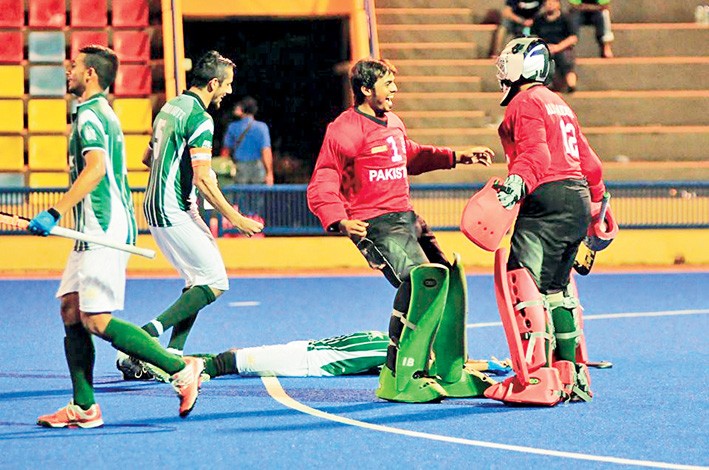

Pakistan’s second position at the eighth Junior Asia Cup in the Malaysian city of Kuantan is the best news for our country’s hockey in recent times.
With this, Pakistan qualified for the next year’s World Cup. After the senior team’s non-appearance at the 2014 World Cup and the failure to qualify for 2016 Olympics, all eyes had been on the juniors.
Some would say that with four berths reserved for Asia at the 11th Junior World Cup in India, it was not a big task. The present times represent the worst period in Pakistan hockey’s history and nothing can be taken for granted.
Only a few months back, the national side had failed to beat lowly-ranked Ireland and France at the World Hockey League semi-finals, which resulted in Pakistan’s failure to make it to the Olympics.
Last month, the newly raised junior string had finished sixth at the Sultan of Johor tournament. Yes, the field there was much stronger than at Kuantan, but to bounce back within such a short time is praiseworthy.
Apart from the final, where Pakistan were outplayed by the much experienced Indian side, the Green-shirts remained impressive.
They won all the three pool games comfortably, including a comprehensive 3-0 victory over the formidable South Korean side.
The bizarre format meant the eight competing teams all qualified for the knockout stage. That meant the winners of the quarter-finals would qualify for the World Cup.
Pakistan faced China, who came from the tougher of the two pools. Despite finishing last, the Chinese had given anxious moments to all the three opponents. It was no different for Pakistan. Until the 44th minute, the match was delicately poised at 2-1 in Pakistan’s favour.
However, the young Green-shirts managed two more goals to secure a place in the World Cup. This was a prominent feature of Pakistan’s show almost throughout: scoring vital goals in the latter part of the match. More was seen in the dramatic semi-final against the South Koreans. Pakistan had defeated the East Asians by three goals in the pool game, so most people expected an easy ride. But the Koreans have always been doughty fighters, especially in the business end of a tournament. They found the net twice inside the first half. With their backs to the wall, the Pakistani lads came back gallantly.
Captain Ammad Shakeel Butt pulled back one off a penalty corner in the 46th minute. Desperate search for the equaliser ensued, but the Koreans stood well. It seemed all over for Pakistan as the last minute arrived. Once again, it was Ammad Butt and once again the goal came off a penalty corner.
The semi-final entered the dreaded penalty shootout. To Pakistan’s horror, the first shot was wasted. Thereafter, both the sides converted all until it came to the last of the five. There was another twist in the story as Korea failed and Pakistan availed themselves of the chance.
Ultimately it came down to the penalty shootout sudden death. First three strikers of each side were successful.
The Hitchcockian suspense finally ended when off the fourth, the Korean couldn’t find the target and the Pakistani did.
The final was between the two traditional powers of Asian hockey. The Indians were the favourites as per the form book, though Pakistanis had also endeared many with their never-say-die approach.
Against the expectations, it turned out to be a one-sided affair. India’s dreaded drag flicker Harmanpreet Singh, the tournament’s top scorer, netted as many as four goals off penalty corners and India won 6-2.
The Indian junior side had been playing together for more than two years, while the Pakistani team had been assembled only two months back.
As many as 10 Indian players had figured in the Hockey India League. In the lucrative HIL, patterned on the lines of cricket’s IPL, has participation from all the major teams of world hockey. Every franchise has to recruit two Indian juniors. This made India a far stronger side, and they were the deserving winners.
Pakistan can take many positives from their display at the eighth Junior Asia Cup. Those who had seen the team only a few weeks back at Johor Bahru remarked, "They looked a completely transformed side at Kuantan. The cohesion and understanding were far better."
During the training camp, a four-match series against a Pakistan ‘A’ side, consisting of the best available national team’s players, was arranged. This experience must have contributed towards improving the teamwork.
As mentioned earlier, the team mostly played well in the second half and also managed to score in the last phases of the matches. That speaks not only about the physical fitness but also the hunger and fighting spirit of the colts.
No less than nine names appeared on the scoring sheets; the side wasn’t dependent on some stars. Goals came via field attempts as well as penalty corners, both direct and variations. Food for thought is very much there. The big defeat against India requires analysis. The Asian teams at any level are not ranked high. It is a long way to go before the Pakistani boys could throw a serious challenge to the top junior teams. Hence, exposure against good European and the Oceanic nations is required.
During Pakistan hockey’s most glorious era, late Brigadier Atif, the secretary of the PHF, used to create competition for various positions in the team. Two or three serious contenders for each slot were scouted for the camps. That gave the selectors more options besides keeping the players on their toes.
When all is said and done, the show at the Junior Asia Cup is a bright ray of sunshine in the darkest period of Pakistan hockey. Qualification for the Junior World Cup has given a lifeline to our dying national game.